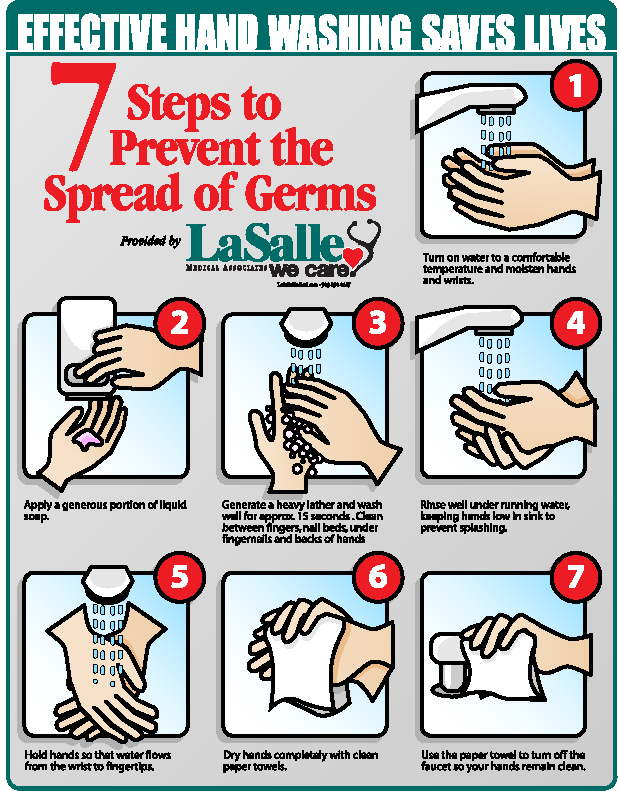Wash Your Hands Like A Doctor To Avoid Getting Sick
(San Bernardino, Calif.) Clean hands save lives! It’s a simple message repeated by health care providers and agencies, such as the Centers for Disease Control and Prevention (CDC), daily.
Keeping hands clean is one of the most effective ways to prevent the spread of infection and illness, such as the common cold and influenza, says Dr. Albert Arteaga, president of LaSalle Medical Associates.
As you touch people, surfaces, pets and objects, you accumulate germs on your hands, and although it’s impossible to keep your hands germ-free, washing your hands frequently can help limit the transfer of germs.
“Just think about all the things you touch everyday. You come in contact with germs all the time, so there are many opportunities to wash your hands,’’ says Arteaga.
Consider these key facts about hand washing from the CDC:
- A third of adults in the U.S. do not wash their hands after using the bathroom.
- One in four adults don’t wash their hands after changing diapers.
- Less than half of Americans wash hands after cleaning after pets.
- A third of adults wash hands after sneezing/coughing.
- Less than one in five adults washes their hands after touching money.
- One in three E. coli occurrences is caused from not washing hands before handling food.
How to Wash
“If hands are kept clean, the transmission of germs from person to person is greatly reduced,” Arteaga says. “But just holding your hands under running water won’t do the trick. There are proper techniques to follow,” he continued.
The best way to effectively eliminate most germs, Dr. Arteaga says, is to wash your hands with soap and water for about 15 to 20 seconds, followed by a good rinse.
“Be sure to wash the backs of your hands, between your fingers where germs can hide, and under your fingernails,’’ Dr. Arteaga says. “You must scrub your hands vigorously for at least 15 to 20 seconds to remove germs.”
For those concerned about time, Dr. Arteaga suggests looking no further than the “ABC Song.” He says singing the “ABC Song,” which is about 20 seconds in length, is not only effective in timing your own hand washing but is a unique way to help children develop their vocabulary skills and understand the importance of proper hand washing.
As an extra precaution, when using public restrooms, Dr. Arteaga suggests drying your hands with a paper towel, using it to turn off the water. Then, before discarding the paper towel, use it to open or close the bathroom door.
In the event a sink and or soap and water are not available, Dr. Arteaga suggests using an alcohol-based hand sanitizer gel or wipes, which are also effective in eliminating germs. But, Dr. Arteaga also points out, soap and water is still best in removing germs and bacteria.
“Many people use alcohol-based hand sanitizers, but if there is visible dirt on your hands, the alcohol-based hand sanitizers are not going to be as effective,’’ he says. “You need to use soap and water to rinse the dirt off your hands. If your hands aren’t visibly dirty, and you do not have soap and water available, make sure the hand sanitizer contains at least 60 percent alcohol to be effective in killing most germs and viruses.”
When to Wash
Wash your hands before and after you eat, use the toilet, change a diaper, touch an animal, blow your nose, cough or sneeze, handle garbage and touch a computer screen or telephone.
Dr. Arteaga says it is also good practice to wash your hands after visiting a park, entering our homes, and using our computers and telephones.
“Repetition is the mother of conversation,’’ he says. “The more you repeat something, the more it becomes ingrained in you to do it. So we must continue to instruct people on the proper way to wash their hands so that they don’t forget.”
Dr. Arteaga and his wife, Maria, a registered nurse, founded LaSalle Medical Associates 27 years ago. He and his team of 120 health care professionals treat thousands of patients for infectious diseases, such as the common cold and seasonal influenza each year.
LaSalle operates clinics in Fontana, Hesperia and San Bernardino.
LaSalle Medical Associates is an Independent Physicians Association (IPA), which has a membership of 1,900 health care professionals serving 190,000 patients in Los Angeles, Riverside, San Bernardino, Fresno, Kings, Madera, San Joaquin and Tulare counties.
For more information about LaSalle Medical Associates, call (909) 890-0407 or go on line to www.LasalleMedical.com.
About LaSalle Medical Associates
LaSalle Medical Associates, Inc., operates four clinics employing more than 120 dedicated healthcare professionals, treating children, adults and seniors in San Bernardino County. LaSalle’s patients are primarily served by Med-Cal and Healthy Families and they also accept Blue Cross, Blue Shield, Molina, Care 1st, Health Net and IEHP. LaSalle’s clinics are at 17577 Arrow Blvd. in Fontana, 16455 Main St. in Hesperia and1505 West 17th St. and 565 N. Mt. Vernon Ave. in San Bernardino.
LaSalle Medical Associates, Inc., is also an Independent Practice Association (IPA) of independently contracted doctors, hospitals and clinics, delivering high quality patience care with more than 190,000 patient visits per year in Fresno, Kings, Los Angeles, Madera, Riverside, San Bernardino, San Joaquin and Tulare Counties.
-end-
Trackback from your site.



